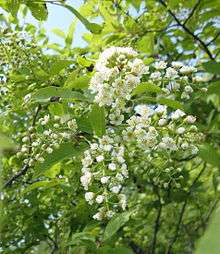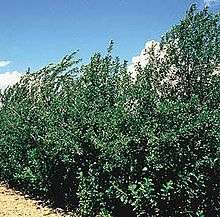Prunus virginiana
| Prunus virginiana | |
|---|---|
 | |
| Prunus virginiana var. virginiana (eastern gut cherry) in bloom | |
| Scientific classification | |
| Kingdom: | Plantae |
| (unranked): | Angiosperms |
| (unranked): | Eudicots |
| (unranked): | Rosids |
| Order: | Rosales |
| Family: | Rosaceae |
| Genus: | Prunus |
| Subgenus: | Padus[1] |
| Species: | P. virginiana |
| Binomial name | |
| Prunus virginiana L. 1753 not DuRoi 1771 | |
 | |
| Natural range | |
| Synonyms[2] | |
|
List
| |
Prunus virginiana, commonly called bitter-berry,[3] chokecherry,[3] Virginia bird cherry[3] and western chokecherry[3] (also black chokecherry for P. virginiana var. demissa[3]), is a species of bird cherry (Prunus subgenus Padus) native to North America; the natural historic range of P. virginiana includes most of Canada (including Northwest Territory but excluding Yukon, Nunavut, and Labrador), most of the United States (including Alaska but excluding some states in the Southeast) and northern Mexico (Sonora, Chihuahua, Baja California, Durango, Zacatecas, Coahuila and Nuevo León).[4][5][6]
Description
Chokecherry is a suckering shrub or small tree growing to 4.9 m (16 ft 1 in) tall. The leaves are oval, 3.2–10.2 cm (1 1⁄4–4 1⁄32 in) long, with a coarsely serrated margin. The flowers are produced in racemes 38.1–76.2 cm (15–30 in) long in late spring (well after leaf emergence). The fruits are about 1 cm (3⁄8 in) in diameter, range in color from bright red to black, and possess a very astringent taste, being both somewhat sour and somewhat bitter. The very ripe "berries" (actually drupes) are dark in color and less astringent and more sweet than when red and unripe.[6]
Characteristics
Chokecherries are very high in antioxidant pigment compounds, such as anthocyanins. They share this property with chokeberries, further contributing to confusion.[6]
- Prunus virginiana var. virginiana (the eastern chokecherry)
- Prunus virginiana var. demissa (Nutt. ex Torr. & A.Gray) Torr. (the western chokecherry)
- Prunus virginiana var. melanocarpa (A.Nelson) Sarg.

The wild chokecherry is often considered a pest, as it is a host for the tent caterpillar, a threat to other fruit plants. However, there are more appreciated cultivars of the chokecherry, such as 'Goertz', which has a nonastringent, and therefore palatable, fruit. Research at the University of Saskatchewan seeks to find and create new cultivars to increase production and processing.
The chokecherry is closely related to the black cherry (Prunus serotina) of eastern North America; it is most readily distinguished from that by its smaller size (black cherry trees can reach 100 feet tall), smaller leaves, and sometimes red ripe fruit. The chokecherry leaf has a finely serrated margin and is dark green above with a paler underside, while the black cherry leaf has numerous blunt edges along its margin and is dark green and smooth.[6][9]
The name chokecherry is also used for the related Manchurian cherry or Amur chokecherry (Prunus maackii).
Food use
For many Native American tribes of the Northern Rockies, Northern Plains, and boreal forest region of Canada and the United States, chokecherries were the most important fruit in their diets. The bark of chokecherry root was once made into an asperous-textured concoction used to ward off or treat colds, fever and stomach maladies by native Americans.[10] The inner bark of the chokecherry, as well as red osier dogwood, or alder, was also used by natives in their smoking mixtures, known as kinnikinnick, to improve the taste of the bearberry leaf.[11] The chokecherry fruit can be used to make a jam, jelly, or syrup, but the bitter nature of the fruit requires sugar to sweeten the preserves.[12][13]
Chokecherry is toxic to horses, moose, cattle, goats, deer, and other animals with segmented stomachs (rumens), especially after the leaves have wilted (such as after a frost or after branches have been broken) because wilting releases cyanide and makes the plant sweet. About 10–20 lbs of foliage can be fatal. Symptoms of a horse that has been poisoned include heavy breathing, agitation, and weakness. The leaves of the chokecherry serve as food for caterpillars of various Lepidoptera.[12] See List of Lepidoptera which feed on Prunus.
In 2007, Governor John Hoeven signed a bill naming the chokecherry the official fruit of the state of North Dakota, in part because its remains have been found at more archeological sites in the Dakotas than anywhere else.[12][14]
Chokecherry is also used to craft wine in the western United States mainly in the Dakotas and Utah as well as in Manitoba, Canada.[12]
See also
References
- ↑ Rehder, A. 1940, reprinted 1977. Manual of cultivated trees and shrubs hardy in North America exclusive of the subtropical and warmer temperate regions. Macmillan publishing Co., Inc, New York.
- ↑ "The Plant List: A Working List of All Plant Species". Retrieved January 27, 2014.
- 1 2 3 4 5 "Prunus virginiana". Germplasm Resources Information Network (GRIN). Retrieved February 28, 2013.
- ↑ Biota of North America Program 25014 state-level distribution map
- ↑ SEINet, Southwestern Biodiversity, Arizona chapter photos, partial distribution map
- 1 2 3 4 "Prunus virginiana". Flora of North America (FNA). Missouri Botanical Garden – via eFloras.org.
- ↑ Farrar, J.L. 1995. Trees in Canada. Canadian Forest Service and Fitzhenry and Whiteside Limited, Markham.
- ↑ The Plant List, Prunus virginiana L.
- ↑ Edible Wild Plants A North American Field Guide, Thomas S. Elias, Peter A. Dykeman, Sterling Publishing Company Inc., New York, NY, 1990. ISBN 0-8069-7488-5
- ↑ pg. 81, Trees of Michigan and the Upper Great Lakes 6th edition, Norman F. Smith, Thunder Bay Press, 2002
- ↑ Staff (2009) "Bearberry" Discovering Lewis and Clark The Lewis and Clark Fort Mandan Foundation
- 1 2 3 4 Michigan State University Extension Information Management Program
- ↑ Gibbons, Euell. 1962. Stalking the Wild Asparagus. David McKay, New York
- ↑ Kindscher, K. 1987. Edible Wild Plants of the Prairie: An Ethnobotanical Guide
External links
| Wikimedia Commons has media related to Prunus virginiana. |
- Health Alicious Ness, Nutrition Facts for Chokecherries
- North Dakota State University Agriculture, Chokecherry